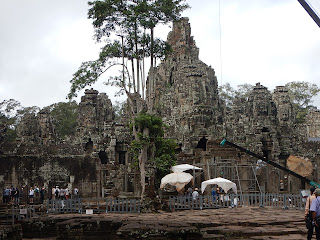Cambodia- an Angkor Art
Angkor meaning
city is the name of a region near the modern city of Seam Reap, part of Seam Reap
province in Cambodia, that was the Center of Kambuja or Kambujadesh,
the historical Kingdom of the Khmer-people from the 9th until the 15th
Century AD. This area is the confluence of Siem
Reap River and Tonley Sap River, part
of it forming a great fresh water lake of about 2500 sq km area. Ultimately it
meets mighty Mekong River 120 km away on the south. This great body of low
depth water as is natural for any sustainable development maintained the
Angkoran Civilization and the Khmer Empire from 802 CE of powerful
Hindu-Buddhist Rule in the South East Asia with its greatest and crumbling
legacy is Angkor. Some of the floating fishing villages are worth visiting during the visit of Angkor.
Restoration project of Naga and Singha images at the
Causeway and outer gateways of Bayon Angkor are in progress under UNESCO. Bayon serves as the monument that serves as the " Churning of Sea of
Milk around which is coiled the Serpentine Vasuki." This is the belt that the
gods and demons use and by their exertion in rotating it as demonstrated on
each causeway from the depth of water come the Elixir of immortality.
In the Face Towers depicting Bodhisattva - Avalokiteshvara
are some of the spectacular sculptures that are witnessed in Bayon temple in
Angkor Thom. In Buddhist philosophy and thoughts a Bodhisattva is a state in
being who has not attained enlightenment and may refrain from Nirvana in the
hopes of aiding others to reach. In Theravada Buddhist, conventionally the term
is applied to hypothetical beings with a high degree of enlighten and power. These
are dated late 12th to 13th century in a period in Angkor
where, may be Hinduism giving way to Buddhism.
Almost all the exterior galleries, that are, today without
roofs have Bas-reliefs on the walls. The Chinese appear in many places, they
form a troupe of foot soldiers, shop owners with Khmer women as wives and in
drunken dance abroad a boat. Other Bas-reliefs show small stall at the market
place, Construction workers plotting a route, Women preparing grilled fish on skewers
and women suffering sickness, Such varied scenes eloquently portray the daily
life of the people. The Bas Reliefs of Angkor Wat also portray the same sort of daily life including Apsaras, Devata.
Over the years the area has overgrown with tree overgrowing the structures, an interesting piece of architecture.
Pictures taken in early October 2015.



















No comments:
Post a Comment